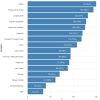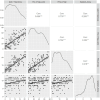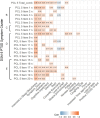Neuropsychiatric symptoms cluster as primary drivers of Long COVID complexity: a South Texas retrospective cohort study
- PMID: 40771985
- PMCID: PMC12325076
- DOI: 10.3389/fneur.2025.1612489
Neuropsychiatric symptoms cluster as primary drivers of Long COVID complexity: a South Texas retrospective cohort study
Abstract
Long COVID, previously known as Post-Acute Sequelae of SARS-CoV-2 (PASC), refers to prolonged symptoms or diagnosable conditions following COVID-19 infection. The neuropsychiatric profile of Long COVID patients remains ambiguous. This study aimed to assess neuropsychiatric symptoms in a retrospective cohort of Long COVID patients (N = 162) at a Rehabilitation Medicine clinic in South Texas. Clinical data from patient records were used to calculate a Symptom Score, and screening tools for stress/PTSD (PCL-5), depression (PHQ-9), anxiety (GAD-7), and quality of life (SWL) were employed to evaluate if Long COVID duration and severity could predict neuropsychiatric outcomes. The majority were female (71%) and Hispanics (53%) who presented for treatment of Long COVID symptoms during the study period, including fatigue (93%), coughing/shortness of breath (81%), fever (67%), anosmia (58%), ageusia (54%), and weight loss (56%). A minority of participants were hospitalized (N = 49) or required ventilator support (N = 5) during acute infection. There was a high burden of neuropsychiatric symptoms, including subjective cognitive impairment (79%), headache (74%), and insomnia (58%). Symptom Score (median = 9, IQR [8,11]) was significantly correlated with increased depression (PHQ-9; p < 0.05), anxiety (GAD-7; p < 0.05) and elevated stress/PTSD (PCL-5; p < 0.05) symptoms. Long COVID patients taking stimulants or mood stabilizers had higher GAD-7 (p < 0.031, p < 0.035) and PHQ-9 (p < 0.034, p < 0.009) scores but not PCL-5 scores. Importantly, duration of Long COVID symptomatology also did not predict PCL-5 scores. No patient factors (e.g., sex, age, BMI, ethnicity) mediated Symptom Score. Nonetheless, historically marginalized groups, such as women and Hispanics, have been disproportionately affected by COVID-19. This study is the first to utilize validated screening tools to determine the presence and severity of neuropsychiatric symptoms in Long COVID patients. These findings may guide clinical management and future research on Long COVID, especially in historically excluded populations.
Keywords: GAD-7; Long COVID; PCL-5; PHQ-9; PTSD; anxiety; depression; stress.
Copyright © 2025 Wells, Rolin, Robles-Ramamurthy, Gibson-Lopez, Goros, Gelfond, Gelfond, Balfanz, Deuter, McGeary and Verduzco-Gutierrez.
Conflict of interest statement
The authors declare that the research was conducted in the absence of any commercial or financial relationships that could be construed as a potential conflict of interest.
Figures




Update of
-
Assessing Neuropsychiatric Symptoms in Long COVID: A Retrospective Cohort Study from a South Texas Long COVID Clinic.medRxiv [Preprint]. 2025 Jun 16:2024.11.03.24316669. doi: 10.1101/2024.11.03.24316669. medRxiv. 2025. Update in: Front Neurol. 2025 Jul 23;16:1612489. doi: 10.3389/fneur.2025.1612489. PMID: 40585077 Free PMC article. Updated. Preprint.
Similar articles
-
Assessing Neuropsychiatric Symptoms in Long COVID: A Retrospective Cohort Study from a South Texas Long COVID Clinic.medRxiv [Preprint]. 2025 Jun 16:2024.11.03.24316669. doi: 10.1101/2024.11.03.24316669. medRxiv. 2025. Update in: Front Neurol. 2025 Jul 23;16:1612489. doi: 10.3389/fneur.2025.1612489. PMID: 40585077 Free PMC article. Updated. Preprint.
-
Signs and symptoms to determine if a patient presenting in primary care or hospital outpatient settings has COVID-19.Cochrane Database Syst Rev. 2022 May 20;5(5):CD013665. doi: 10.1002/14651858.CD013665.pub3. Cochrane Database Syst Rev. 2022. PMID: 35593186 Free PMC article.
-
The Black Book of Psychotropic Dosing and Monitoring.Psychopharmacol Bull. 2024 Jul 8;54(3):8-59. Psychopharmacol Bull. 2024. PMID: 38993656 Free PMC article. Review.
-
Multidisciplinary collaborative guidance on the assessment and treatment of patients with Long COVID: A compendium statement.PM R. 2025 Jun;17(6):684-708. doi: 10.1002/pmrj.13397. Epub 2025 Apr 22. PM R. 2025. PMID: 40261198
-
Interventions for palliative symptom control in COVID-19 patients.Cochrane Database Syst Rev. 2021 Aug 23;8(8):CD015061. doi: 10.1002/14651858.CD015061. Cochrane Database Syst Rev. 2021. PMID: 34425019 Free PMC article.
References
-
- WHO . Director-general’s opening remarks at the media briefing. (2023). Available online at: https://www.who.int/director-general/speeches/detail/who-director-genera... (Accessed May 05, 2023).
-
- Cascella M, Rajnik M, Cuomo A, Dulebohn SC, Di Napoli R. Features, evaluation, and treatment of coronavirus (COVID-19) In: StatPearls [Internet]. Treasure Island (FL): StatPearls Publishing; (2023) - PubMed
Grants and funding
LinkOut - more resources
Full Text Sources
Miscellaneous

